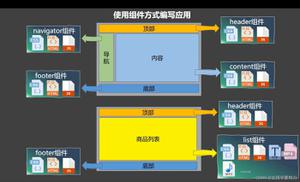vue2.0组件快速入门

前言
最近开始在学vue相关的内容。组件这章的内容比较多。看了http://www.cnblogs.com/keepfool/p/5625583.html这篇博客,博主总结的还比较全面也挺清晰,可是这篇博客的知识点跟实例都是基于vue 1.0版本的,所以参考这篇博客,我将vue2.0版本中的相关知识点做了一个总结。算是自己学习的一个笔记
什么是组件?
组件 (Component) 是 Vue.js 最强大的功能之一。组件可以扩展 HTML 元素,封装可重用的代码。我们可以将组件看成是封装好的HTML元素。
本文的所有代码,都放在github上面https://github.com/xuxiaozhi/vue-tutorials,有需要的可以下载查看。
组件的注册和使用
全局注册
注册一个组件
要注册一个全局组件,你可以使用 Vue.component(tagName, options)来注册。如下实例:
//1、注册一个全局的组件。要确保在初始化实例之前注册Vue.component('my-component',{
template:"<div>这是第一个组件</div>"
})
//创建跟实例
new Vue({
el:"#app"
})
使用组件
组件在注册之后,便可以在父实例的模块中以自定义元素 <my-component></my-component> 的形式使用。
注意:要确保组件是在初始化实例之前注册,要不然使用的时候会报错
<div id="app"><my-component></my-component>
</div>
组件使用后在页面中,将渲染成以下结构
局部注册组件
我们不必全局注册每一个组件,根据实际情况需要,我们可以采用局部注册的方式注册组件。如下实例
new Vue({ el:"#app",
components:{
'my-component':{
template:"<div>这个是局部注册的组件</div>"
}
}
})
♥注意
局部注册的组件仅在当前注册的实例或者组件内部使用。在其他地方引用将会报错,如下:
<div id="app"><my-component></my-component>
</div>
<div id="app2">
<my-component></my-component>
</div>
在上述实例中,我们在”#app“元素所在的实例中,注册了一个组件,然后在“#app”和“#app2”内引用,查看源代码发现,只有“#app”内的组件渲染成了html代码,而在“#app2”内只是一个无意义的标签,如下图所示:
字符串模板
在组件中,我们一般使用字符串模板,字符串模板,主要有以下三种形式
- 使用
script标签 - 使用
template标签 - 单文件组件
使用<script标签
<!DOCTYPE html><html>
<head>
<meta charset="UTF-8">
<title>组件相关</title>
</head>
<body>
<div id="app">
<my-component></my-component>
</div>
<script type="text/x-template" id="myComponent">
<div>这是script模板</div>
</script>
</body>
<script type="text/javascript" src="../js/vue.js" ></script>
<script type="text/javascript">
//全局注册一个组件
Vue.component('my-component',{
template:"#myComponent"
})
new Vue({
el:"#app"
})
</script>
</html>
注意点:
需要给script设置一个id,使用的时候,直接引用该id即可
使用<script>标签时,type指定为text/x-template,意在告诉浏览器这不是一段js脚本,浏览器在解析HTML文档时会忽略<script>标签内定义的内容。
使用template标签
template标签的用法跟script是一样的,区别在于template标签不需要设置type,直接设置一个id即可,一般情况下,我们建议使用这种方式来创建模板。如下所示
<template id="myComponent"><div>这是script模板</div>
</template>
单文件组件
所谓的单文件组件是指创建.vue后缀的文件,并不是我们上面所说的全局注册一个组件或者局部注册一个组件,这个知识点后面再单独说明
父子组件
组件 A 在它的模版中使用了组件 B。则A跟B就构成了父子组件的关系。在 Vue 中,父子组件的关系可以总结为 props down, events up。父组件通过 props 向下传递数据给子组件,子组件通过 events 给父组件发送消息。看看它们是怎么工作的。
子组件获取父组件的数据
默认情况下,子组件不能访问父组件的数据。子组件如果需要拿到父组件的数据,需要通过子组件的 props 选项。
子组件要拿到父组件的数据,有以下两个步骤:1、子组件要显式地用 props 选项声明它期待获得的数据。2、通过v-bind将数据绑定到子组件的模板上,
为了更好的理解,我们可以将new Vue()这个根组件看成是my-component的父组件。那么父组件向子组件传递数据,我们可以通过以下实例来说明:
<!DOCTYPE html><html>
<head>
<meta charset="UTF-8">
<title>组件相关</title>
<link rel="stylesheet" type="text/css" href="../css/bootstrap.min.css"/>
</head>
<body>
<div id="app">
<!--通过v-bind将父组件的数据绑定到子组件的模板上-->
<my-component :Columns="columns" :Users="users"></my-component>
</div>
<template id="myComponent">
<table class="table table-bordered table-striped">
<thead>
<tr>
<th>name</th>
<th>age</th>
<th>email</th>
</tr>
</thead>
<tbody>
<tr v-for="item in Users">
<td v-for="col in Columns">{{item[col]}}</td>
</tr>
</tbody>
</table>
</template>
</body>
<script type="text/javascript" src="../js/vue.js" ></script>
<script type="text/javascript">
new Vue({
el:"#app",
data:{
columns:['name','age','sex'],
users:[{
name: 'Jack',
age: 30,
sex: 'Male'
}, {
name: 'Bill',
age: 26,
sex: 'Male'
}, {
name: 'Tracy',
age: 22,
sex: 'Female'
}, {
name: 'Chris',
age: 36,
sex: 'Male'
}]
},
components:{
'my-component':{
template:"#myComponent",
//1、props显示的申明子组件想要获取的数据
props:{
'Columns':Array,
'Users':Array
}
}
}
})
</script>
</html>
上述代码再页面中的运行结果如下图:
说明:
props有两种使用方式,当我们使用上述实例中的方式的时候,可以验证数据的格式,如果格式不正确会报错。我们还可以直接使用数组来申明子组件想要获取的数据,如['Columns','Users']
父组件获取子组件的数据
子组件如果需要把数据传递给父组件,那么我们就需要用到自定义的事件。这个过程主要包括两个步骤,1、使用vm.$emit(event,[...args])触发事件,2、父组件可以在使用子组件的地方直接用 v-on 来监听子组件触发的事件。在下面实例中,我们点击子组件,没点一次数据增加1,然后把这个值传递给父组件
<!DOCTYPE html><html>
<head>
<meta charset="UTF-8">
<title>组件相关</title>
<link rel="stylesheet" type="text/css" href="../css/bootstrap.min.css"/>
</head>
<body>
<div id="app">
<!--通过v-bind将父组件的数据绑定到子组件的模板上-->
<p>{{total}}</p>
<!--在使用子组件的地方用v-on来监听子组件的事件变化-->
<button-counter v-on:increment="get"></button-counter>
</div>
</body>
<script type="text/javascript" src="../js/vue.js" ></script>
<script type="text/javascript">
new Vue({
el:"#app",
data:{
total:0
},
methods:{
get:function(res){
this.total=res;
}
},
components:{
'button-counter':{
template:'<button v-on:click="increment">{{ counter }}</button>',
//1、props显示的申明子组件想要获取的数据
data:function(){
return {
counter:0
}
},
methods:{
increment:function(){
this.counter+=1;
//1、在子组件中,使用$emit来触发事件。
this.$emit('increment',this.counter)
}
}
}
}
})
</script>
</html>
运行效果如图:点击下面的按钮的时候,上面的数据会相应的发生改变
运行demo
slot
slot是vue中用于内容分发的,通俗的说slot其实是一个内容插槽,我们也可以把它理解成一个占位符。我们可以在模板中使用这个占位符设置一些默认的内容,当我们使用这个模板时,如果我们重新设置了内容,这个占位符会替换成我们想要替换的内容,当我们不设置的时候,默认的就是显示这个占位符中的内容。下面让我们用一个实例来理解slot.
单个slot
<!DOCTYPE html><html>
<head>
<meta charset="UTF-8">
<title>组件相关</title>
<link rel="stylesheet" type="text/css" href="../css/bootstrap.min.css"/>
</head>
<body>
<div id="app">
<my-component>
<h1>我是替换后的标题</h1>
</my-component>
<hr>
<my-component></my-component>
</div>
<template id="myComponent">
<div>
<slot><h1>我是默认标题</h1></slot>
</div>
</template>
</body>
<script type="text/javascript" src="../js/vue.js" ></script>
<script type="text/javascript">
Vue.component('my-component',{
template:"#myComponent"
})
new Vue({
el:"#app"
})
</script>
</html>
上面的代码,在页面中渲染成了以下所示:当我们没有重新设置替换内容的时候,slot中的内容会显示,当我们重新设置了 则slot中的内容不会再显示了,页面中显示的是我们设置后的内容
具名slot
<slot> 元素可以用一个特殊的属性 name 来配置如何分发内容。多个 slot 可以有不同的名字。具名 slot 将匹配内容片段中有对应 slot 特性的元素。仍然可以有一个匿名 slot,它是默认 slot,作为找不到匹配的内容片段的备用插槽。如果没有默认的 slot,这些找不到匹配的内容片段将被抛弃。看一下下面的实例,假设我们有一个下面一样的模板。这个模板被分成了三部分,
<template id="myComponent"><div class="container">
<header>
<slot name="header"><h1>我是默认标题</h1></slot>
</header>
<main>
<slot name="content">
<p>我是默认内容</p>
</slot>
</main>
<footer>
<slot name="footer">
<p>我是默认底部</p>
</slot>
</footer>
</div>
</template>
这个模板被分为了三部分,每一部分都设置了一些默认的内容。这些插槽是通过name和slot对应关联的,当我们使用这个模板时,如果我们重置了header跟footer中的内容,而content中的内容我们不设置,如下:
<my-component><h1 slot="header">我是设置后的标题</h1>
<p slot="footer">我是设置后的底部</p>
</my-component>
那么页面中渲染如下图:
以上是 vue2.0组件快速入门 的全部内容, 来源链接: utcz.com/z/375439.html





